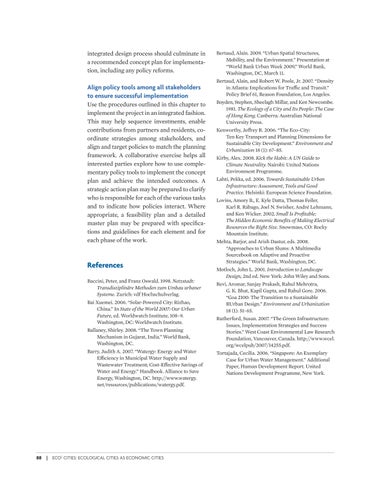integrated design process should culminate in a recommended concept plan for implementation, including any policy reforms.
Bertaud, Alain. 2009. “Urban Spatial Structures, Mobility, and the Environment.” Presentation at “World Bank Urban Week 2009,” World Bank, Washington, DC, March 11.
Align policy tools among all stakeholders to ensure successful implementation
Bertaud, Alain, and Robert W. Poole, Jr. 2007. “Density in Atlanta: Implications for Traffic and Transit.” Policy Brief 61, Reason Foundation, Los Angeles.
Use the procedures outlined in this chapter to implement the project in an integrated fashion. This may help sequence investments, enable contributions from partners and residents, coordinate strategies among stakeholders, and align and target policies to match the planning framework. A collaborative exercise helps all interested parties explore how to use complementary policy tools to implement the concept plan and achieve the intended outcomes. A strategic action plan may be prepared to clarify who is responsible for each of the various tasks and to indicate how policies interact. Where appropriate, a feasibility plan and a detailed master plan may be prepared with specifications and guidelines for each element and for each phase of the work.
References Baccini, Peter, and Franz Oswald. 1998. Netzstadt: Transdisziplinäre Methoden zum Umbau urbaner Systeme. Zurich: vdf Hochschulverlag. Bai Xuemei. 2006. “Solar-Powered City: Rizhao, China.” In State of the World 2007: Our Urban Future, ed. Worldwatch Institute, 108–9. Washington, DC: Worldwatch Institute. Ballaney, Shirley. 2008. “The Town Planning Mechanism in Gujarat, India.” World Bank, Washington, DC. Barry, Judith A. 2007. “Watergy: Energy and Water Efficiency in Municipal Water Supply and Wastewater Treatment; Cost-Effective Savings of Water and Energy.” Handbook. Alliance to Save Energy, Washington, DC. http://www.watergy. net/resources/publications/watergy.pdf.
88
|
ECO2 CITIES: ECOLOGICAL CITIES AS ECONOMIC CITIES
Boyden, Stephen, Sheelagh Millar, and Ken Newcombe. 1981. The Ecology of a City and Its People: The Case of Hong Kong. Canberra: Australian National University Press. Kenworthy, Jeffrey R. 2006. “The Eco-City: Ten Key Transport and Planning Dimensions for Sustainable City Development.” Environment and Urbanization 18 (1): 67–85. Kirby, Alex. 2008. Kick the Habit: A UN Guide to Climate Neutrality. Nairobi: United Nations Environment Programme. Lahti, Pekka, ed. 2006. Towards Sustainable Urban Infrastructure: Assessment, Tools and Good Practice. Helsinki: European Science Foundation. Lovins, Amory B., E. Kyle Datta, Thomas Feiler, Karl R. Rábago, Joel N. Swisher, André Lehmann, and Ken Wicker. 2002. Small Is Profitable: The Hidden Economic Benefits of Making Electrical Resources the Right Size. Snowmass, CO: Rocky Mountain Institute. Mehta, Barjor, and Arish Dastur, eds. 2008. “Approaches to Urban Slums: A Multimedia Sourcebook on Adaptive and Proactive Strategies.” World Bank, Washington, DC. Motloch, John L. 2001. Introduction to Landscape Design, 2nd ed. New York: John Wiley and Sons. Revi, Aromar, Sanjay Prakash, Rahul Mehrotra, G. K. Bhat, Kapil Gupta, and Rahul Gore. 2006. “Goa 2100: The Transition to a Sustainable RUrban Design.” Environment and Urbanization 18 (1): 51–65. Rutherford, Susan. 2007. “The Green Infrastructure: Issues, Implementation Strategies and Success Stories.” West Coast Environmental Law Research Foundation, Vancouver, Canada. http://www.wcel. org/wcelpub/2007/14255.pdf. Tortajada, Cecilia. 2006. “Singapore: An Exemplary Case for Urban Water Management.” Additional Paper, Human Development Report. United Nations Development Programme, New York.
